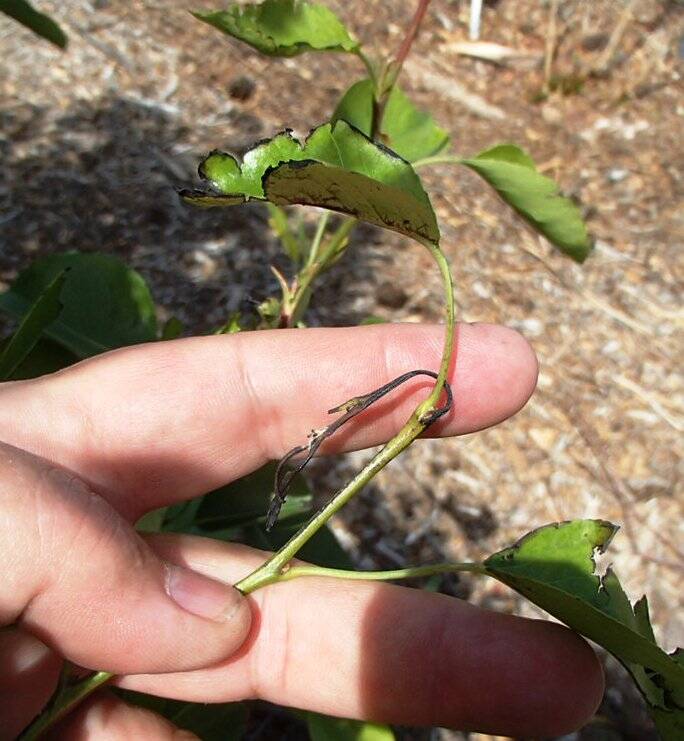Be on the lookout for fireblight disease
Anyone growing Asian pear or Bartlett European pear should be on the lookout for fireblight disease, which has been rearing its ugly head over the past couple of weeks.
The strong winds are a big part of the problem. Fireblight, or fireblight disease, is one of the few bacterial plant diseases that threaten cultivated fruit trees and ornamentals. Most plant diseases are fungal, not bacterial, and so chemical treatment is more limited. This disease can be a plant killer.
Any of the Asian pears (20th Century, Shinseki and Hosui, for example) are the hardest hit. Next are European pears with common Bartlett being in the lead because there are more Bartletts planted. But this can include Bosc or Comice as well.
Apples are next depending on their genetics (Pink Lady and Mutsu are susceptible) along with several types of quince. Some European pears are resistant (Red Sensation Bartlett and Kieffer as examples), but if they have any Asian pear genetics in them (like Tennosui), they will be susceptible.
Susceptible plants frequently have open flowers when there are strong winds (or they may have open wounds from very recent pruning). This bacterial disease can infect susceptible plants through fresh wounds or flowers. If the disease travels into the central trunk, then the tree will die. Get control of this disease as soon as it is seen.
Ornamental plants are also susceptible. Ornamental flowering pear (nurseries may call them Callery pear but they are a European pear), flowering or red leaf plum, pyracantha, cotoneaster of all types and garden roses — depending on genetics — can be hit hard or lightly.
Look for these three things if you suspect your plant is infected: the characteristic fire-scorched black color on new growth, a shepherd’s hook at the end of soft and succulent new growth, and the tiny oozing sores that are common to bacterial fireblight. To confirm your plant has it, look for the tiny sores on the blackened growth and discolored oozing that characterize this disease.
What to do? Sprays are, for the most part, wishful. Instead, prune about 12 inches lower than where you see the black discoloration starting. That’s very important. Be aggressive and surgical.
Disinfect your pruning blades with at least 70 percent alcohol between each pruning cut. When you are finished, immediately dispose of these prunings in a tied plastic bag far away from the infected tree. Be careful of the oozing sores because that’s how the disease is spread.
Q: I have several Lady Banks roses planted along my wall in a raised bed. They are getting a sticky substance on some of the leaves. Should I be removing some thick stems growing at the plant base?
A: The sticky substance is honeydew from aphids mostly in the spring. Aphid control is a major reason for applying dormant oil in the winter. This is not Neem oil.
Dormant oils are either made from petroleum or paraffin. Dormant oils are not organic because of their source. It is probably the most important winter spray for ornamental plants to control the future soft-bodied insects such as aphids, whiteflies, scale insects among others.
Lady Banks roses are huge. They are 20 feet tall and 20 feet wide when semi-mature. For a rose, use a lot of water because these plants are huge.
Unlike garden roses that are repeat bloomers, these produce flowers only once in the spring and they are finished. The flowers they produce are either yellow or white depending on which plant you selected. Other times of the year, the plants are green with leaves.
The way these plants get bigger is through the production of suckers that grow at the base of the plant. That’s what you’re seeing. Most people allow these suckers to grow so the plant gets bigger. This also means more water as they get larger.
Q: Why am I only getting a small amount of fruit from my apricot and peach tree during the past two years? In past years we got lots of fruit from these trees.
A: Do you remember freezing temperatures during the past two years in February or early March? Any temperatures below 32 degrees killed the flowers but not the tree. All trees, regardless of whether they are citrus, peach or apricot, have cold-sensitive flowers. Their open flowers freeze at 32 degrees; flower buds tolerate slightly colder temperatures but still close to 32 degrees.
What temperatures kill the trees outright depends on the tree’s genetics, but apples are killed around 0 degrees and warmer; pears around the same and warmer; peaches and apricots around 10 to 15 degrees and warmer; figs and pomegranates around 15 to 20 degrees and warmer; and citrus from 25 to 32 degrees depending upon the variety.
All open flowers freeze at the same temperature. Some plants flower later in the spring or even early summer. Citrus like kumquat flower multiple times during the year. Pomegranate, fig and jujube also flower multiple times during the year and start producing flowers later in the season. Persimmon flowers later in the spring or early summer.
Early flowering peaches produce early fruit. Peach trees that flower later in the spring generally produce fruit later in the season.
Every year, count on the earliest peaches to produce flowers that last two or three weeks starting the first week of February. These early peaches finish flowering by the third week of February. Peach trees that produce fruit later start flowering the second or third week in February and may not finish flowering until mid-March. Ninety percent of the time Las Vegas will not have freezing temperatures after March 15 but it could happen.
Buy a waterproof, battery-operated, 10-day recording maximum and minimum thermometer. It costs about $15. The batteries will last about one year. Hang it in your peach tree. During the late winter or early spring, if your peach tree had open flowers and the minimum temperature was below 32 degrees, you probably lost some fruit.
Q: My Jerusalem sage plant is starting to turn yellow. The plant produces beautiful yellow flowers, which I deadheaded. I’m now getting a second batch of flowers. However, the leaves are turning yellow. Each plant has two 2-gallon-per-hour emitters and gets watered four times a week for 35 minutes. This one gets morning sun and is against a southern facing wall.
A: Here are some things I consider when plants are yellowing: poor drainage, watering too often, soil improvement and location.
We are starting to get into the hot months and putting it near a south-facing wall is not a good idea. This plant is from the Mediterranean area. There is just too much heat radiating within about 3 or 4 feet from a south-facing wall. Our desert climate has very high solar radiation, not like the Mediterranean.
Some plants can handle heat better if they have adequate nutrition. It’s not just the fertilizer but it’s also how the soil is prepared.
Make sure the soil drains and has about 30 percent compost mixed with it. The roots will be in the top 12 inches of soil so don’t water the plant in this location until a soil moisture meter reads around five or less with the tip about 3 to 4 inches deep.
Look at where the yellowing is occurring. If the yellowing is on the newest growth, then it’s not nitrogen. If you are using a rich compost laden with fertilizer, then don’t add any more fertilizer.
If the yellowing is on older growth and the soil hasn’t been amended for a while, then it might be nitrogen. Be careful because this yellowing can also be confused with overwatering or poor drainage. When adding a fertilizer for nitrogen, make sure this first number is the highest of the three.
Bob Morris is a horticulture expert and professor emeritus of the University of Nevada, Las Vegas. Visit his blog at xtremehorticulture.blogspot.com. Send questions to Extremehort@aol.com.





























